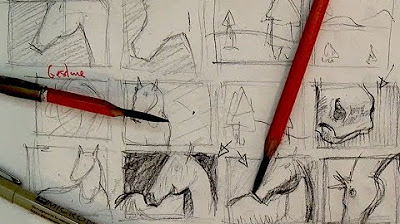Simplify Your Digital Painting Process
Summary
TLDRThis digital painting tutorial walks viewers through the process of creating a landscape painting, from initial thumbnail sketches to final post-processing. The artist focuses on composition, color blocking, and establishing depth through perspective and temperature variations in the artwork. Detailed steps include refining the foreground, adding textures, and painting atmospheric elements like clouds. The video emphasizes layering techniques and finishing touches like vignette effects to create a polished piece. Viewers are encouraged to apply these skills through their own assignments, with suggestions to focus on color and process for a rewarding artistic outcome.
Takeaways
- 😀 Start with thumbnail sketches to plan the composition and layout of your painting.
- 😀 Focus on balancing the sky-to-ground ratio to create a visually appealing structure.
- 😀 Use perspective grid tools to ensure accurate proportions and perspective in the painting.
- 😀 Begin the painting process by blocking in large shapes and applying flat colors.
- 😀 Experiment with color temperature to create depth by using warm and cool tones in different elements.
- 😀 Pay attention to the interaction between clouds and the composition, using light and shadow to add dimension.
- 😀 Separate elements like trees, buildings, and roads into different layers for easier adjustments.
- 😀 Add texture and variation to elements like trees and grass by using textured brushes.
- 😀 Use post-processing techniques like linear dodge and soft light to adjust lighting and color harmony.
- 😀 Add a vignette effect around the edges of the painting to focus attention on the main subject.
- 😀 Revisit your painting to adjust final details, ensuring edges, values, and colors feel cohesive and balanced.
Q & A
What is the first step in creating a digital painting from the reference photo?
-The first step is to establish the drawing of the subject using the reference photo. The goal is to capture the basic forms and structure of the subject accurately before moving into color and details.
How does the artist approach the initial block-in phase of the painting?
-The artist begins by filling in large areas of color to establish the basic color structure of the painting. This phase is more about getting a rough idea of the overall color scheme rather than focusing on details.
Why does the artist recommend using a landscape or still life for the assignment?
-The artist recommends a landscape or still life because these types of subjects have fewer challenges related to figure drawing and form, allowing the artist to focus more on color and painting techniques.
What is the purpose of the 'block-in' stage in digital painting?
-The 'block-in' stage serves to set the foundation for the painting by filling in large areas of color. It helps the artist establish the overall color palette and composition before refining the details.
How does the artist approach refining the edges and values during the painting process?
-The artist carefully goes over the painting multiple times to refine the edges, adjust values, and add subtle details. This process ensures that the painting looks polished and cohesive.
What role does post-processing play in the digital painting process?
-Post-processing allows the artist to add finishing touches, such as a vignette or other effects, to enhance the overall composition and give the painting a final, cohesive look.
What is the significance of the thumbnail sketches mentioned in the video?
-Thumbnail sketches are used to design the composition before starting the final painting. They help the artist experiment with different layouts, perspectives, and elements to determine the best approach.
How should the artist approach final details and adjustments in the painting?
-The artist should comb through the painting, paying attention to any details or edges that may need refinement. Adjustments to values, highlights, or shadows can help bring the painting to life.
What is the benefit of choosing a personal reference photo for the assignment?
-Choosing a personal reference photo allows the artist to work with a subject they are comfortable with, ensuring they can focus on developing their skills without being overwhelmed by unfamiliar subject matter.
What additional resource does the artist recommend for those struggling with the painting process?
-For those struggling, the artist recommends checking out the full course at proko.com/digitalpainting, which offers more comprehensive lessons and detailed instructions for improving digital painting skills.
Outlines

This section is available to paid users only. Please upgrade to access this part.
Upgrade NowMindmap

This section is available to paid users only. Please upgrade to access this part.
Upgrade NowKeywords

This section is available to paid users only. Please upgrade to access this part.
Upgrade NowHighlights

This section is available to paid users only. Please upgrade to access this part.
Upgrade NowTranscripts

This section is available to paid users only. Please upgrade to access this part.
Upgrade NowBrowse More Related Video

How to Draw Tips | What are thumbnail sketches? How to use them

[Part 1] Easiest Beginner iPad Procreate Portrait Tutorial Ever!

Getting Started: Robot Targets - RoboDK Documentation

Album Cover Illustration process - from sketch to print!

The Truth About Painting Landscapes From Photos

【大型トラック塗装】新車状態から全塗装してカスタム お見せします! 新型スーパーグレート FUSO SUPERGREAT セノプロ
5.0 / 5 (0 votes)